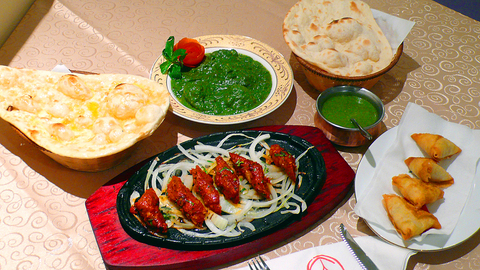One of Taipei's oldest and most reputed Indian restaurants, Tandoor Indian Restaurant, has recently found a new home in the multicultural Tienmu neighborhood serving the same authentic North Indian cuisine and an enchanting interior design mixing elegance with modern chic.
Named after the traditional Indian clay oven, Tandoor takes its native recipes seriously and imports all the spices and herbs from India. For each dish, at least 10 to 12 spices are used.
"Many people ask us if we make changes to appeal to local palates. I always reply that there is no such need since the menu is so extensive, diners are bound to find something to their liking," said manager Monisha Relwani.

PHOTO: HO YI, TAIPEI TIMES
Relwani's confidence is not unfounded since the restaurants experienced Indian chefs study the ancient combinations of spices and are skilled at making over 100 different sauces.
For appetizers, the barbecued delicacies come highly recommended as they are roasted in the tandoor in the traditional way. Seekh kabab (NT$290), or the roasted minced mutton, is one of the most-ordered dishes.
The Indian gravies come in three basic kinds: yellow, which is made of various vegetables and ginger powder; red, which is either tomato or chili-based; and green, which is the spinach-based. The vindaloo is not for the faint-hearted. If you prefer something milder, chicken saagwalla (NT$300) has a slight tang of spices mixed with the fresh flavor of spinach.
Arguably the world's favorite Indian dish, chicken tikka masala (NT$350), cooked with green peppers, onions and spices, is perfect with a basket of garlic naan (NT$70), according to Relwani.
"All our meats are deboned and skinned since North Indian cuisine was traditionally served at the imperial family's dinning table and the royal family liked their food immaculately prepared," the manager explained.
As for the vegetable options, aloo gobi (NT$220), or cauliflower and potatoes cooked with dry herbs and spices and chana masala (NT$220), which is chickpeas cooked in traditional Punjabi style with a thick spicy gravy, are two must-tries for vegetarians.
A tip to Tandoor's customers: ask for a doggie bag for leftovers since the sauces are the soul of the food and excellent seasonings for bread, rice or noodles.

That US assistance was a model for Taiwan’s spectacular development success was early recognized by policymakers and analysts. In a report to the US Congress for the fiscal year 1962, former President John F. Kennedy noted Taiwan’s “rapid economic growth,” was “producing a substantial net gain in living.” Kennedy had a stake in Taiwan’s achievements and the US’ official development assistance (ODA) in general: In September 1961, his entreaty to make the 1960s a “decade of development,” and an accompanying proposal for dedicated legislation to this end, had been formalized by congressional passage of the Foreign Assistance Act. Two

March 31 to April 6 On May 13, 1950, National Taiwan University Hospital otolaryngologist Su You-peng (蘇友鵬) was summoned to the director’s office. He thought someone had complained about him practicing the violin at night, but when he entered the room, he knew something was terribly wrong. He saw several burly men who appeared to be government secret agents, and three other resident doctors: internist Hsu Chiang (許強), dermatologist Hu Pao-chen (胡寶珍) and ophthalmologist Hu Hsin-lin (胡鑫麟). They were handcuffed, herded onto two jeeps and taken to the Secrecy Bureau (保密局) for questioning. Su was still in his doctor’s robes at

Last week the Democratic Progressive Party (DPP) said that the budget cuts voted for by the China-aligned parties in the legislature, are intended to force the DPP to hike electricity rates. The public would then blame it for the rate hike. It’s fairly clear that the first part of that is correct. Slashing the budget of state-run Taiwan Power Co (Taipower, 台電) is a move intended to cause discontent with the DPP when electricity rates go up. Taipower’s debt, NT$422.9 billion (US$12.78 billion), is one of the numerous permanent crises created by the nation’s construction-industrial state and the developmentalist mentality it

Experts say that the devastating earthquake in Myanmar on Friday was likely the strongest to hit the country in decades, with disaster modeling suggesting thousands could be dead. Automatic assessments from the US Geological Survey (USGS) said the shallow 7.7-magnitude quake northwest of the central Myanmar city of Sagaing triggered a red alert for shaking-related fatalities and economic losses. “High casualties and extensive damage are probable and the disaster is likely widespread,” it said, locating the epicentre near the central Myanmar city of Mandalay, home to more than a million people. Myanmar’s ruling junta said on Saturday morning that the number killed had